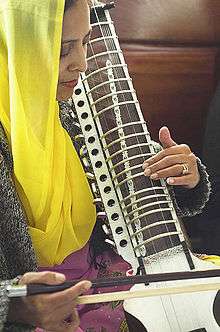Sikh music

Sikh music or Shabad kirtan is Kirtan-style singing of hymns or Shabad from the Guru Granth Sahib, the central text of Sikhism.
It began in the late 16th century as the musical expression of mystical poetry, accompanied by a musical instrument rabab, by Bhai Mardana an early follower of Guru Nanak –the founder of Sikhism.[1] Following Nanak, all the Sikh gurus sang in the then-prevalent classical and folk music styles, accompanied by stringed and percussion instruments. The style was where the text was of prime significance and the music played a supporting, albeit important, role. The Gurus specified the raag for each hymn in the Sikh sacred scripture, the Guru Granth Sahib.[1]
Significant efforts have been under way since the 1970s to revive the rich Sikh music tradition initiated and developed by the Sikh Gurus. Various terms used to refer to this tradition include Shabad keertan parampara, Gurbani sangeet parampara and Gurmat sangeet.
Practice
Devotional singing in Sikhism is called a Kirtan.[2][3] It is typically performed at Gurdwaras (Sikh temples), wherein Sikh scriptures and legends are recited in a song, set to a certain raga and accompanied with music. A Shabad Kirtan refers to the musical recitation of the Guru Granth Sahib, the primary scripture in the Sikhism tradition.[4] The Shabad Kirtan is silently listened to by the gathered congregation.[2]
A Kirtan in Sikh history has been the musical analog of Kathas recitation, both preferably performed by ragi jatha, or professional trained performers.[2] A Sikh Kirtan is a religious, aesthetic and social event, usually held in a congregational setting on Sundays or over certain festivals to honor the historical Gurus, but major temples in the Sikh tradition recite Kirtan everyday as a mark of daily bhakti (devotional remembrance) of God's name.[2] The congregational setting is called a Sangat or Satsang, a word that in ancient Indian texts means "like minded individuals, or fellow travelers on a spiritual journey".[5][6]
Sikh musicians
Three types of Sikh musicians are rababis, ragis, and dhadhis.
Raga: melodic scales
Ragas have a direct relationship to human moods and the following are the connections between Ragas and feeling:
- Soohi – joy and separation
- Bilaaval – happiness
- Gaund – strangeness, surprise, beauty
- Sri – satisfaction and balance
- Maajh – loss, beautification
- Gauri – seriousness
- Aasa – making effort
- Gujri – satisfaction, softness of heart, sadness
- Devgandhari – no specific feeling but the Raag has a softness
- Bihaagra – beautification
- Sorath – motivation
- Dhanasari – inspiration, motivation
- Jaitsree – softness, satisfaction, sadness
- Todi – this being a flexible Raag it is apt for communicating many feelings
- Bhairaagi – sadness, (The Gurus have, however, used it for the message of *Bhakti)
- Tilang – this is a favourite Raag of Muslims. It denotes feeling of beautification and yearning.
- Raamkali – calmness
- Nat Narayan – happiness
- Maali Gaura – happiness
- Maaru – giving up of cowardice
- Tukhari – beautification
- Kedara – love and beautification
- Bhairav – seriousness, brings stability of mind
- Basant – happiness
- Sarang – sadness
- Malaar – separation
- Jaijawanti – viraag
- Kalyaan – Bhakti Ras
- Vadhans – vairaag, loss (that is why Alahniya is sung in this Raag when someone passes away)
- Parbhati – Bhakti and seriousness
- Kaanra – Bhakti and seriousness
In addition to raag names, there exists an indication in the titles of hymns called ghar. The precise meaning of ghar is not fully understood, although recent research proposes it refers to raag variants.[7]
Gallery
-

A Sikh playing the Dilruba which was developed by Guru Gobind Singh
-

Guru Arjan Dev's own Rebab
See also
Notes
- 1 2 Christopher Shackle; Arvind Mandair (2013). Teachings of the Sikh Gurus: Selections from the Sikh Scriptures. Routledge. pp. xxiii–xxiv. ISBN 978-1-136-45108-9.
- 1 2 3 4 Knut A. Jacobsen; Kristina Myrvold (2012). Sikhs Across Borders: Transnational Practices of European Sikhs. Bloomsbury Academic. pp. 112–114. ISBN 978-1-4411-7087-3.
- ↑ Arvind-Pal Singh Mandair (2013). Sikhism: A Guide for the Perplexed. A&C Black. p. 24. ISBN 978-1-4411-0231-7.
- ↑ Knut A. Jacobsen; Kristina Myrvold (2012). Sikhs Across Borders: Transnational Practices of European Sikhs. Bloomsbury Academic. p. 113. ISBN 978-1-4411-7087-3.
- ↑ Arvind-Pal Singh Mandair (2013). Sikhism: A Guide for the Perplexed. A&C Black. pp. 30–31. ISBN 978-1-4411-0231-7.
- ↑ Frisk, Liselotte (2002). "The Satsang Network". Nova Religio. 6 (1): 64–85.
- ↑ See Inderjit N Kaur, .
Further reading
- Chopra, R. M., Glory of Sikhism - Chapter on "Music in Sikhism", ISBN 783473471195.
- Masukhani, Gobind Singh. 1982. Indian Classical Music and Sikh Kirtan.
External links
- Shabad Kirtan Gurbani Keertan, Hymns & Ragas
- Sikh Sangeet - High Quality Shabad Kirtan MP3s
- Sikh Music Heritage Institute
- Kirtan Audio & Video Database
- Soulful Gurbani Kirtan Downloads
- Gurmaat Sangeet Kirtan of Gurbani categorized by shabads
